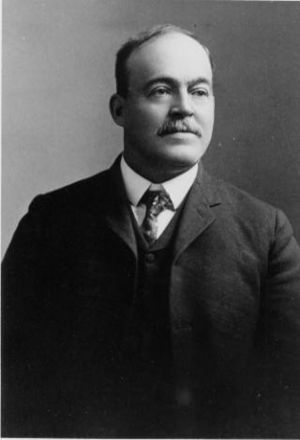Edward Herbert Thompson facts for kids
Quick facts for kids
Edward Herbert Thompson
|
|
|---|---|

Edward Herbert Thompson
|
|
| Born | September 28, 1857 |
| Died | May 11, 1935 (aged 77) |
| Nationality | American |
| Known for | Maya civilization |
| Scientific career | |
| Fields | archaeology |
Edward Herbert Thompson (born September 28, 1857 – died May 11, 1935) was an American archaeologist. He also worked for a long time as a consul (a government official who helps citizens) in Yucatán, Mexico. Thompson is well-known for his important studies of the ancient Maya civilization.
Contents
Edward Herbert Thompson: Explorer of the Maya World
Edward Herbert Thompson was born in Worcester, Massachusetts, USA. He spent most of his life studying the amazing Maya civilization.
Early Life and Interest in Maya
In 1879, Thompson wrote an article called "Atlantis Not a Myth." It was published in a magazine called Popular Science Monthly. In his article, Thompson suggested that the old civilizations in North and Central America might be linked to the lost continent of Atlantis.
This article caught the eye of Stephen Salisbury III. Salisbury was a rich man from Worcester who was very interested in the Maya. He was also a main supporter of the American Antiquarian Society. Salisbury and other members of this society convinced Thompson to move to Yucatán. They wanted him to explore the Maya ruins there. In return, Thompson would become an American Consul.
Living and Learning in Yucatán
Thompson arrived in Mérida, Yucatán, in 1885. He lived in Yucatán for 40 years. When he first arrived, he only spoke English. But he quickly learned Spanish. He also became very good at speaking the Yucatec Maya language.
Thompson was one of the first explorers to study and dig at several Maya sites. These sites were in the Puuc region. Some of them included Loltun and Labná. At Labná, he wrote a book about Maya underground storage containers called chultunes. He also found and explored a small site he named X'Kichmook.
In 1893, Thompson made plaster copies of Maya sculptures and buildings. These copies were mostly from Uxmal and Labná. They were shown at the World Columbian Exposition in Chicago, Illinois.
Discoveries at Chichen Itza
In 1894, Thompson bought a large piece of land that included the famous Maya site of Chichen Itza. He rebuilt the main house, called a hacienda, which had been destroyed in a war. For 30 years, he explored Chichen Itza. He worked for several museums and societies, like the Field Columbian Museum and the Peabody Museum at Harvard University.
One of his important finds was the oldest dated carving on a stone beam in the Temple of the Initial Series. He also dug up several graves in the Ossario, also known as the High Priest’s Temple.
Thompson is most famous for exploring the Cenote Sagrado (Sacred Cenote). A cenote is a natural pit, or sinkhole, that has water. From 1904 to 1911, he used a dredge (a machine that scoops things from the bottom of water) to explore this sacred well. He found many valuable items. These included artifacts made of gold, copper, and carved jade. He also found the first examples of Maya cloth and wooden weapons from before Christopher Columbus arrived.
Thompson sent most of these amazing artifacts to the Peabody Museum. Later, in 1926, the Mexican government took control of Thompson's land. They believed he had taken the artifacts without permission. However, in 1944, the Mexican Supreme Court decided that Thompson had acted correctly. Edward Thompson had passed away in 1935, so his property at Hacienda Chichen went to his family.
See also
 In Spanish: Edward Herbert Thompson para niños
In Spanish: Edward Herbert Thompson para niños

